MAZDA CX9 2023 Owners Manual
Manufacturer: MAZDA, Model Year: 2023, Model line: CX9, Model: MAZDA CX9 2023Pages: 739, PDF Size: 11.69 MB
Page 151 of 739
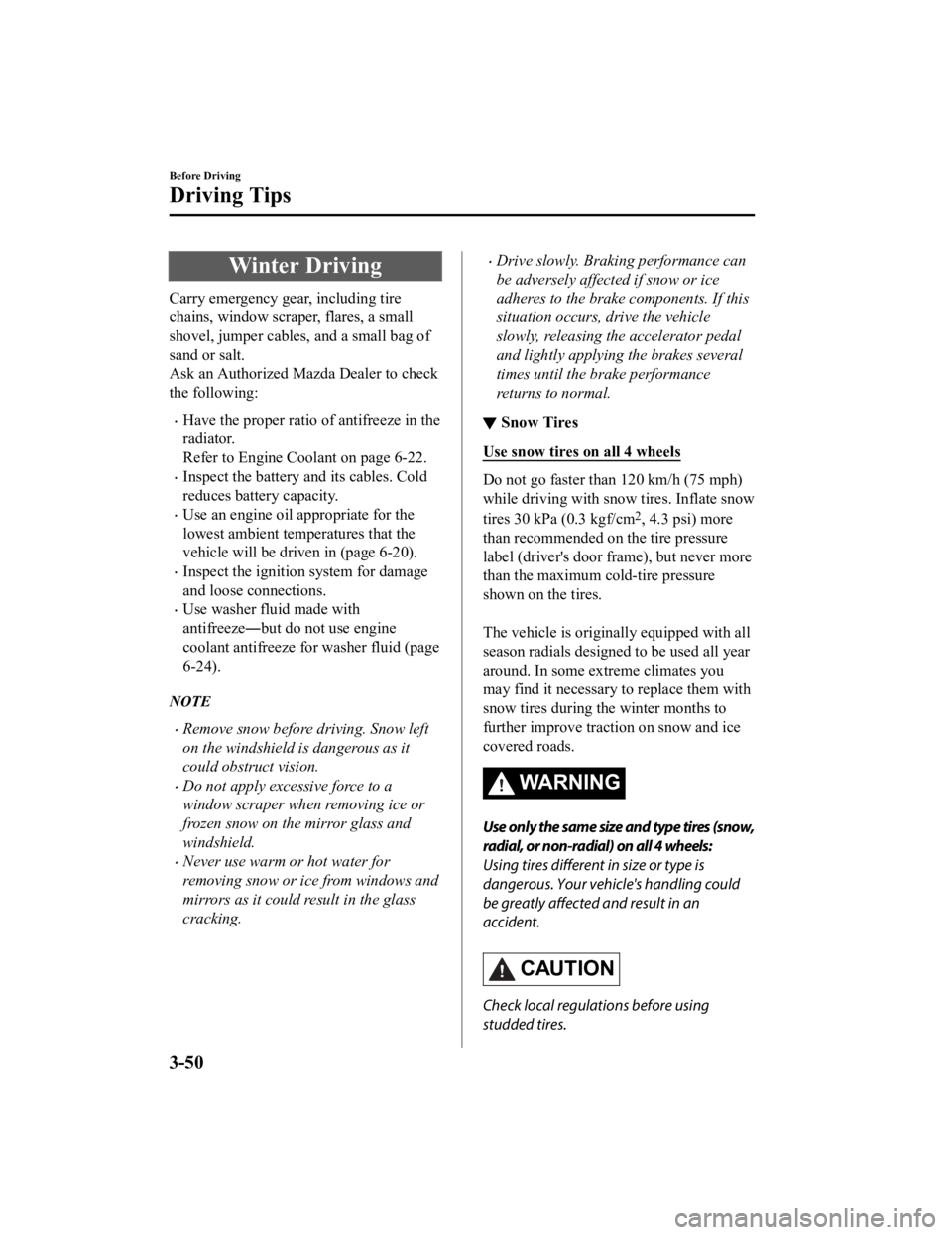
Winter Driving
Carry emergency gear, including tire
chains, window scraper, flares, a small
shovel, jumper cables, and a small bag of
sand or salt.
Ask an Authorized Mazda Dealer to check
the following:
Have the proper ratio of antifreeze in the
radiator.
Refer to Engine Coolant on page 6-22.
Inspect the battery and its cables. Cold
reduces battery capacity.
Use an engine oil appropriate for the
lowest ambient temperatures that the
vehicle will be driven in (page 6-20).
Inspect the ignition system for damage
and loose connections.
Use washer fluid made with
antifreeze―but do not use engine
coolant antifreeze for washer fluid (page
6-24).
NOTE
Remove snow before driving. Snow left
on the windshield is dangerous as it
could obstruct vision.
Do not apply excessive force to a
window scraper when removing ice or
frozen snow on the mirror glass and
windshield.
Never use warm or hot water for
removing snow or ice from windows and
mirrors as it could result in the glass
cracking.
Drive slowly. Braking performance can
be adversely affected if snow or ice
adheres to the brake components. If this
situation occurs, drive the vehicle
slowly, releasing the accelerator pedal
and lightly applying the brakes several
times until the brake performance
returns to normal.
▼ Snow Tires
Use snow tires on all 4 wheels
Do not go faster than 120 km/h (75 mph)
while driving with sno
w tires. Inflate snow
tires 30 kPa (0.3 kgf/cm
2, 4.3 psi) more
than recommended on the tire pressure
label (driver's door frame), but never more
than the maximum c old-tire pressure
shown on the tires.
The vehicle is originally equipped with all
season radials designed to be used all year
around. In some extreme climates you
may find it necessary t o replace them with
snow tires during the winter months to
further improve traction on snow and ice
covered roads.
WA R N I N G
Use only the same size and type tires (snow,
radial, or non-radial) on all 4 wheels:
Using tires different in size or type is
dangerous. Your vehi cle's handling could
be greatly affected and result in an
accident.
CAUTION
Check local regulations before using
studded tires.
Before Driving
Driving Tips
3-50
CX-9_8LJ2-EA-22H_Edition1_old 2022-6-9 13:33:08
Page 152 of 739
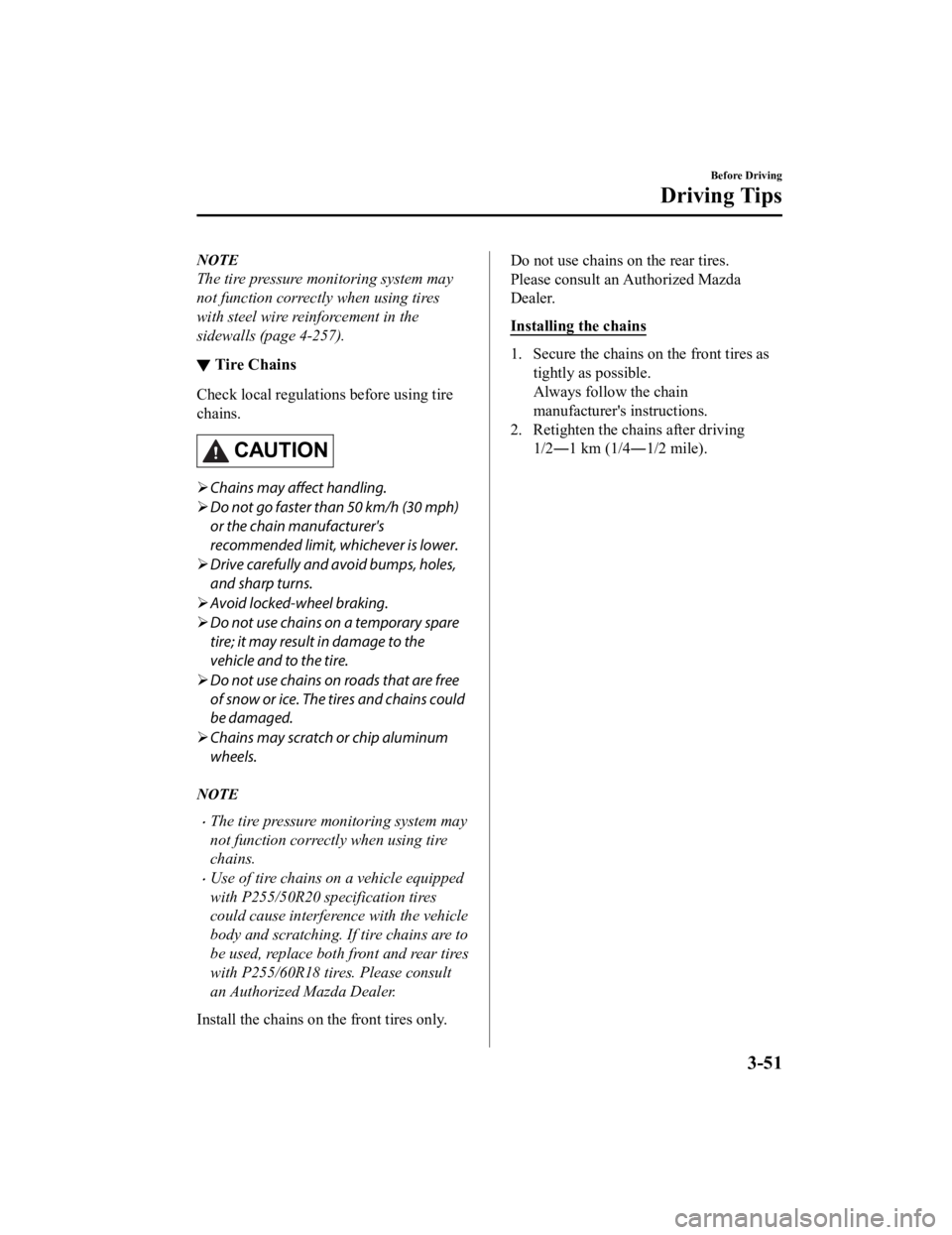
NOTE
The tire pressure monitoring system may
not function correctly when using tires
with steel wire reinforcement in the
sidewalls (page 4-257).
▼ Tire Chains
Check local regulations before using tire
chains.
CAUTION
Chains may affect handling.
Do not go faster than 50 km/h (30 mph)
or the chain manufacturer's
recommended limit, whichever is lower.
Drive carefully and avoid bumps, holes,
and sharp turns.
Avoid locked-wheel braking.
Do not use chains on a temporary spare
tire; it may result in damage to the
vehicle and to the tire.
Do not use chains on roads that are free
of snow or ice. The tires and chains could
be damaged.
Chains may scratch or chip aluminum
wheels.
NOTE
The tire pressure monitoring system may
not function correctly when using tire
chains.
Use of tire chains on a vehicle equipped
with P255/50R20 specification tires
could cause interference with the vehicle
body and scratching. If tire chains are to
be used, replace both front and rear tires
with P255/60R18 tires. Please consult
an Authorized Mazda Dealer.
Install the chains on the front tires only.
Do not use chains on the rear tires.
Please consult an Authorized Mazda
Dealer.
Installing the chains
1. Secure the chains on the front tires as
tightly as possible.
Always follow the chain
manufacturer's instructions.
2. Retighten the chains after driving 1/2―1 km (1/4―1/2 mile).
Before Driving
Driving Tips
3-51
CX-9_8LJ2-EA-22H_Edition1_old 2022-6-9 13:33:08
Page 153 of 739
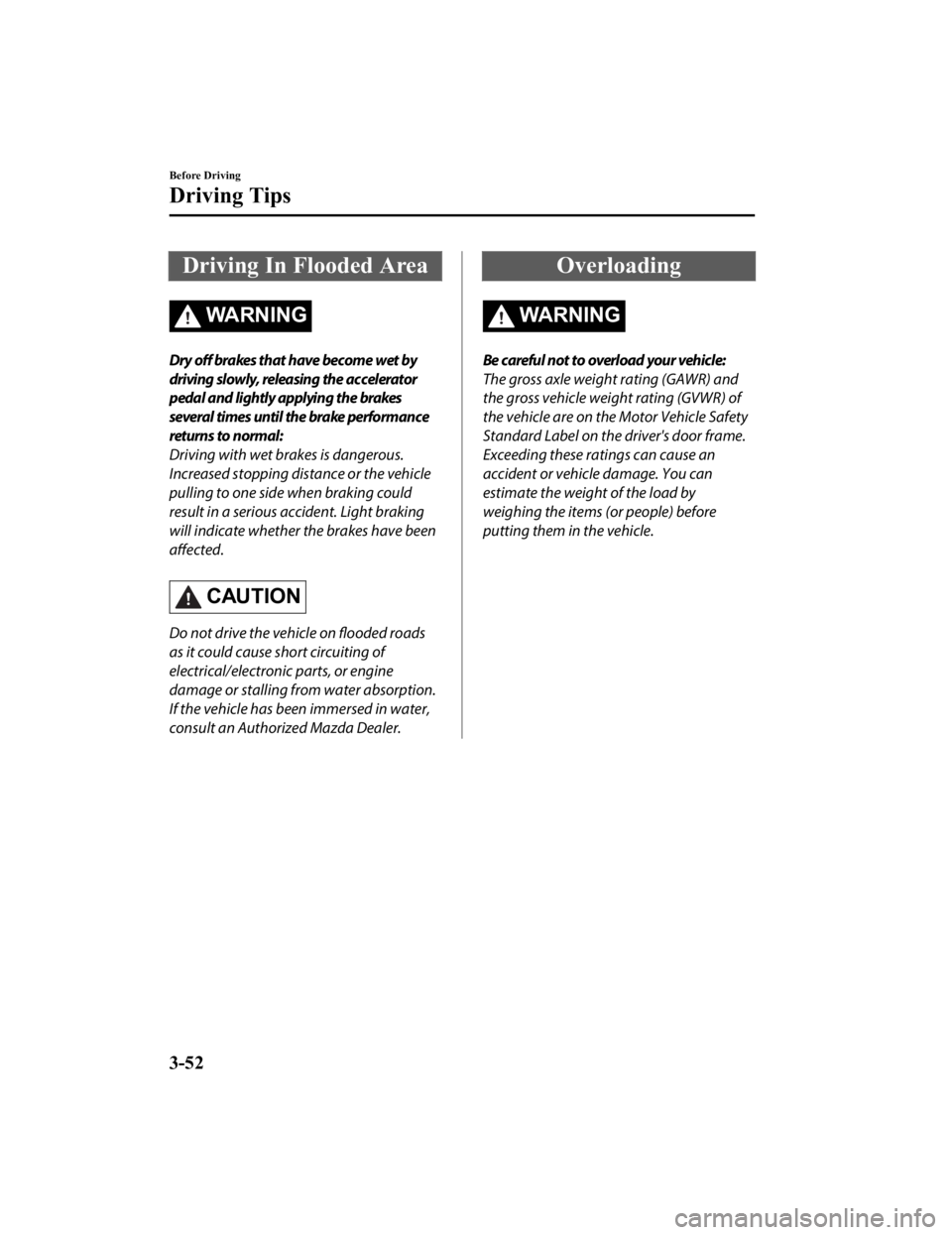
Driving In Flooded Area
WA R N I N G
Dry off brakes that have become wet by
driving slowly, releasing the accelerator
pedal and lightly applying the brakes
several times until the brake performance
returns to normal:
Driving with wet brakes is dangerous.
Increased stopping distance or the vehicle
pulling to one side when braking could
result in a serious accident. Light braking
will indicate whether the brakes have been
affected.
CAUTION
Do not drive the vehicle on flooded roads
as it could cause short circuiting of
electrical/electronic parts, or engine
damage or stalling from water absorption.
If the vehicle has been immersed in water,
consult an Authorized Mazda Dealer.
Overloading
WA R N I N G
Be careful not to overload your vehicle:
The gross axle weight rating (GAWR) and
the gross vehicle weight rating (GVWR) of
the vehicle are on the Motor Vehicle Safety
Standard Label on the driver's door frame.
Exceeding these ratings can cause an
accident or vehicle damage. You can
estimate the weight of the load by
weighing the items (or people) before
putting them in the vehicle.
Before Driving
Driving Tips
3-52
CX-9_8LJ2-EA-22H_Edition1_old2022-6-9 13:33:08
Page 154 of 739
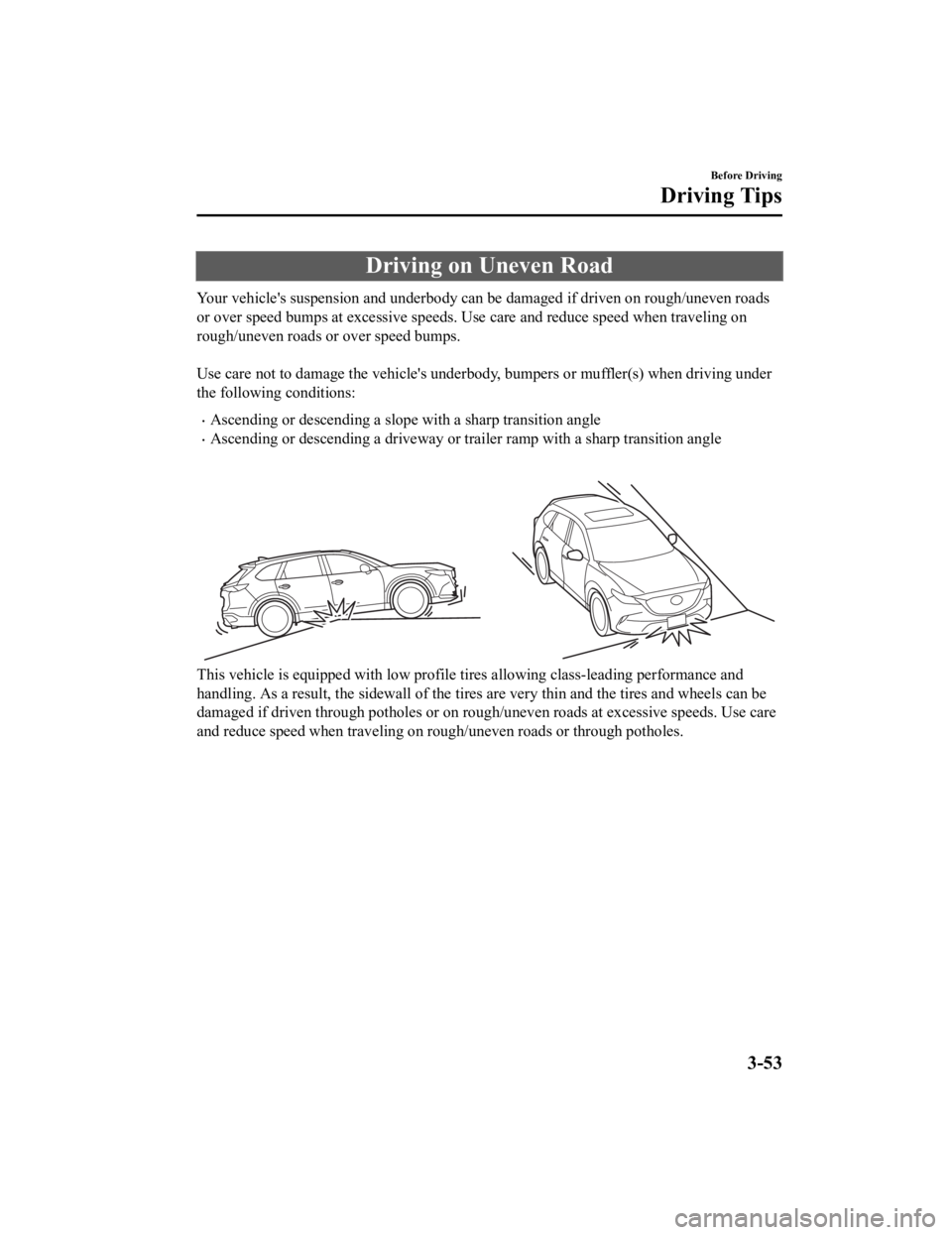
Driving on Uneven Road
Your vehicle's suspension and underbody can be damaged if driven on rough/uneven roads
or over speed bumps at excessive speeds. Use care and reduce sp eed when traveling on
rough/uneven roads or over speed bumps.
Use care not to damage the vehicle's underbody, bumpers or muff ler(s) when driving under
the following conditions:
Ascending or descending a slope w ith a sharp transition angle
Ascending or descending a driveway or trailer ramp with a sharp transition angle
This vehicle is equipped with l ow profile tires allowing class- leading performance and
handling. As a result , the sidewall of the tires are very thin and the tires and wheels can be
damaged if driven through potholes or on rough/uneven roads at excessive speeds. Use care
and reduce speed when traveling on rough/uneven roads or through potholes.
Before Driving
Driving Tips
3-53
CX-9_8LJ2-EA-22H_Edition1_old 2022-6-9 13:33:08
Page 155 of 739

Turbocharger Information
CAUTION
After driving at freeway speeds or up a long hill, trailer towing for a long time, idle the
engine at least 30 seconds before stoppi ng it. Otherwise, the turbocharger could be
damaged.
Racing or over-revving the engine, particularly after it's just been started, can damage the
turbocharger.
To protect the engine from damage, the engine is designed so that it cannot be raced just
after starting it in extremely cold weather.
The turbocharger greatly enhances engine power. Its advanced de sign provides improved
operation and requires minimum maintenance.
To get the most from it, observe the following.
1. Change engine oil and filter according to Scheduled Maintenan ce (page 6-4).
2. Use only recommended engine oil (page 6-20). Extra additives are NOT recommended.
Before Driving
Driving Tips
3-54
CX-9_8LJ2-EA-22H_Edition1_old 2022-6-9 13:33:08
Page 156 of 739
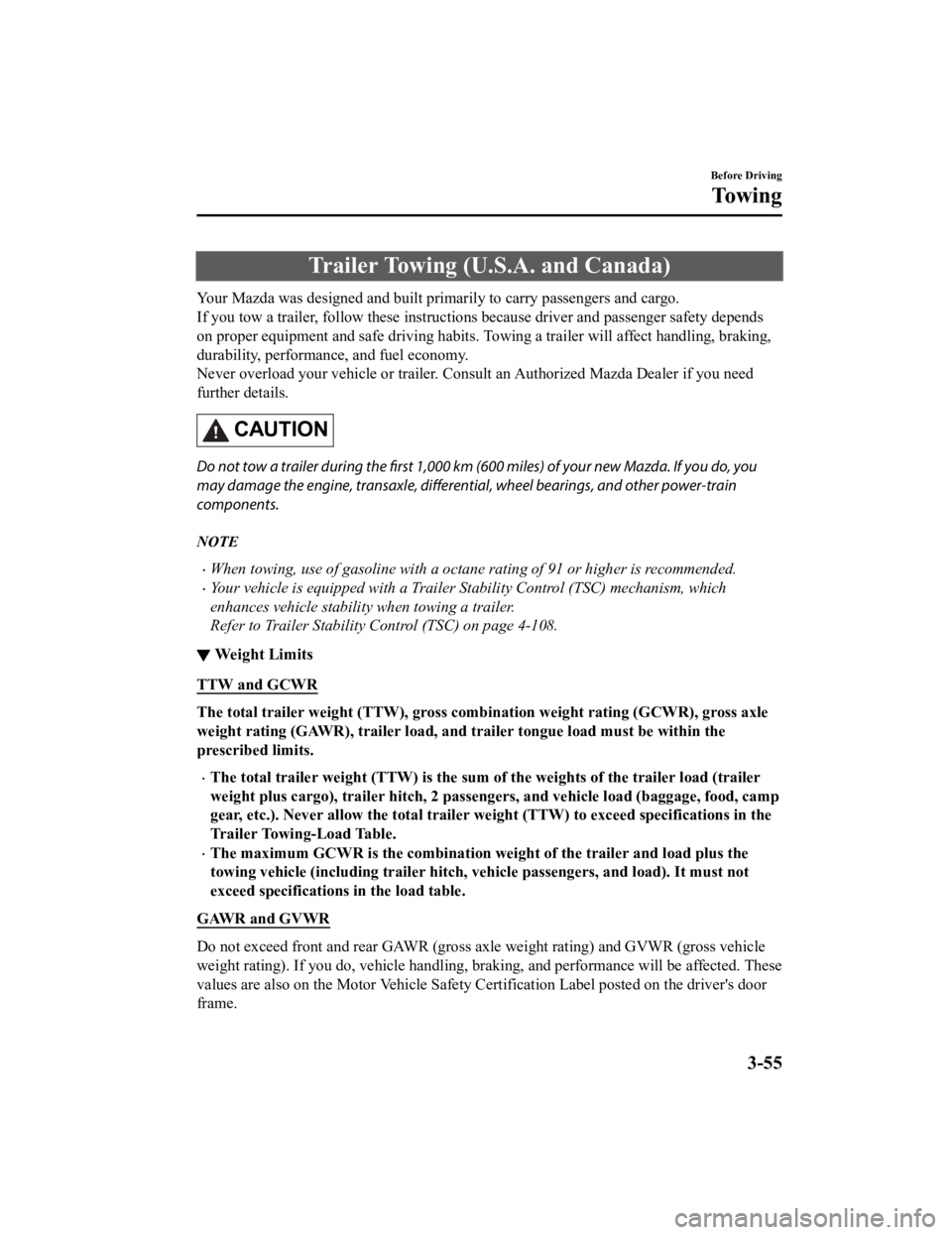
Trailer Towing (U.S.A. and Canada)
Your Mazda was designed and built primarily to carry passengers and cargo.
If you tow a trailer, follow thes e instructions because driver and passenger safety depends
on proper equipment and safe d riving habits. Towing a trailer w ill affect handling, braking,
durability, performance, and fuel economy.
Never overload your vehicle or trailer. Consult an Authorized M azda Dealer if you need
further details.
CAUTION
Do not tow a trailer during the first 1,000 km (600 miles) of your new Mazda. If you do, you
may damage the engine, transaxle, differential, wheel bearings, and other power-train
components.
NOTE
When towing, use of gasoline with a octane rating of 91 or higher is recommended.
Your vehicle is equipped with a Trailer Stability Control (TSC) mechanism, which
enhances vehicle stability when towing a trailer.
Refer to Trailer Stability Control (TSC) on page 4-108.
▼ Weight Limits
TTW and GCWR
The total trailer weight (TTW), g
ross combination weight rating (GCWR), gross axle
weight rating (GAWR), trailer load, and trailer tongue load mus t be within the
prescribed limits.
The total trailer weight (TTW) i s the sum of the weights of the trailer load (trailer
weight plus cargo), trailer hitch, 2 passengers, and vehicle load (baggage, food, camp
gear, etc.). Never allow the tota l trailer weight (TTW) to exceed specifications in the
Trailer Towing-Load Table.
The maximum GCWR is the combinat ion weight of the trailer and load plus the
towing vehicle (including trailer hitch, vehicle passengers, and load). It must not
exceed specifications in the load table.
GAWR and GVWR
Do not exceed front and rear GAWR (gross axle weight rating) an d GVWR (gross vehicle
weight rating). If you do, vehicle handling, braking, and perfo rmance will be affected. These
values are also on the Motor Vehicle Safety Certification Label posted on the driver's door
frame.
Before Driving
To w i n g
3-55
CX-9_8LJ2-EA-22H_Edition1_old 2022-6-9 13:33:08
Page 157 of 739
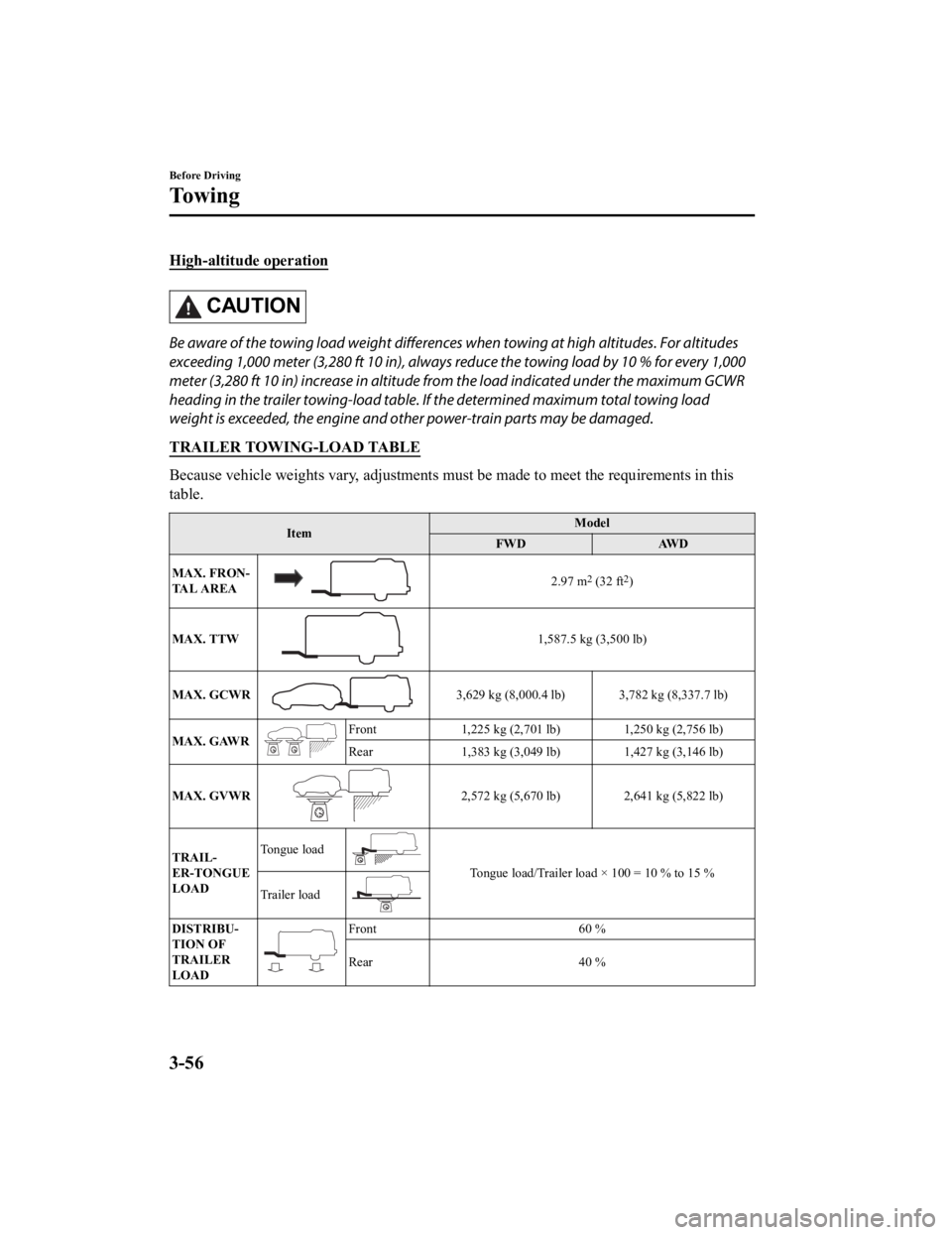
High-altitude operation
CAUTION
Be aware of the towing load weight differences when towing at high altitudes. For altitudes
exceeding 1,000 meter (3,280 ft 10 in), always reduce the towing load by 10 % for every 1,000
meter (3,280 ft 10 in) increase in altitude from the load indicated under the maximum GCWR
heading in the trailer towing-load table. If the determined maximum total towing load
weight is exceeded, the engine and other power-train parts may be damaged.
TRAILER TOWING-LOAD TABLE
Because vehicle weights vary, ad justments must be made to meet the requirements in this
table.
Item Model
FWD AWD
MAX. FRON‐
TA L A R E A
2.97 m2 (32 ft2)
MAX. TTW
1,587.5 kg (3,500 lb)
MAX. GCWR
3,629 kg (8,000.4 lb) 3,782 kg (8,337.7 lb)
MAX. GAWR
Front 1,225 kg (2,701 lb) 1,250 kg (2,756 lb)
Rear 1,383 kg (3,049 lb) 1,427 kg (3,146 lb)
MAX. GVWR
2,572 kg (5,670 lb) 2,641 kg (5,822 lb)
TRAIL‐
ER-TONGUE
LOAD Tongue load
Tongue load/Trailer load × 100 = 10 % to 15 %
Trailer load
DISTRIBU‐
TION OF
TRAILER
LOADFront 60 %
Rear 40 %
Before Driving
To w i n g
3-56
CX-9_8LJ2-EA-22H_Edition1_old 2022-6-9 13:33:08
Page 158 of 739
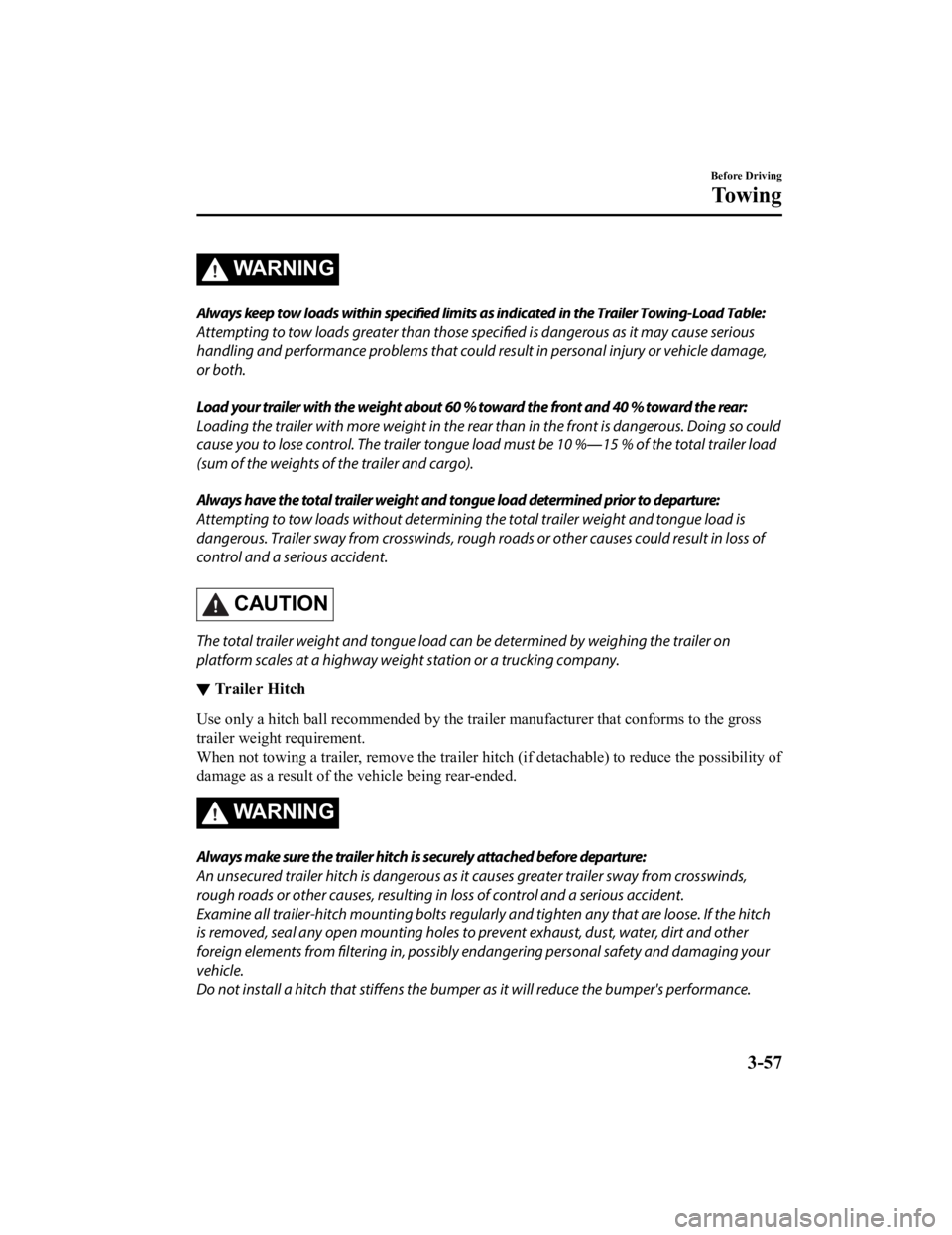
WA R N I N G
Always keep tow loads within specified limits as indicated in the Trailer Towing-Load Table:
Attempting to tow loads greater than those specified is dangerous as it may cause serious
handling and performance problems that could result in personal injury or vehicle damage,
or both.
Load your trailer with the weight about 60 % toward the front and 40 % toward the rear:
Loading the trailer with more weight in the rear than in the front is dangerous. Doing so could
cause you to lose control. The trailer tongue load must be 10 % ―15 % of the total trailer load
(sum of the weights of the trailer and cargo).
Always have the total trailer weight and tongue load determined prior to departure:
Attempting to tow loads withou t determining the total trailer weight and tongue load is
dangerous. Trailer sway from crosswinds, roug h roads or other causes could result in loss of
control and a serious accident.
CAUTION
The total trailer weight and tongue load ca n be determined by weighing the trailer on
platform scales at a highway weight station or a trucking company.
▼ Trailer Hitch
Use only a hitch ball recommended by the trailer manufacturer that conforms to the gross
trailer weight requirement.
When not towing a trailer, remove
the trailer hitch (if detachable) to reduce the possibility of
damage as a result of the vehicle being rear-ended.
WA R N I N G
Always make sure the trailer hitch is securely attached before departure:
An unsecured trailer hitch is dangerous as it causes greater trailer sway from crosswinds,
rough roads or other causes, resulting in loss of control and a serious accident.
Examine all trailer-hitch mounting bolts regularly and tighten any that are loose. If the hitch
is removed, seal any open mounting holes to prevent exhaust, dust, water, dirt and other
foreign elements from filtering in, possibly en dangering personal safety and damaging your
vehicle.
Do not install a hitch that stiffens the bumper as it will reduce the bumper's performance.
Before Driving
To w i n g
3-57
CX-9_8LJ2-EA-22H_Edition1_old 2022-6-9 13:33:08
Page 159 of 739
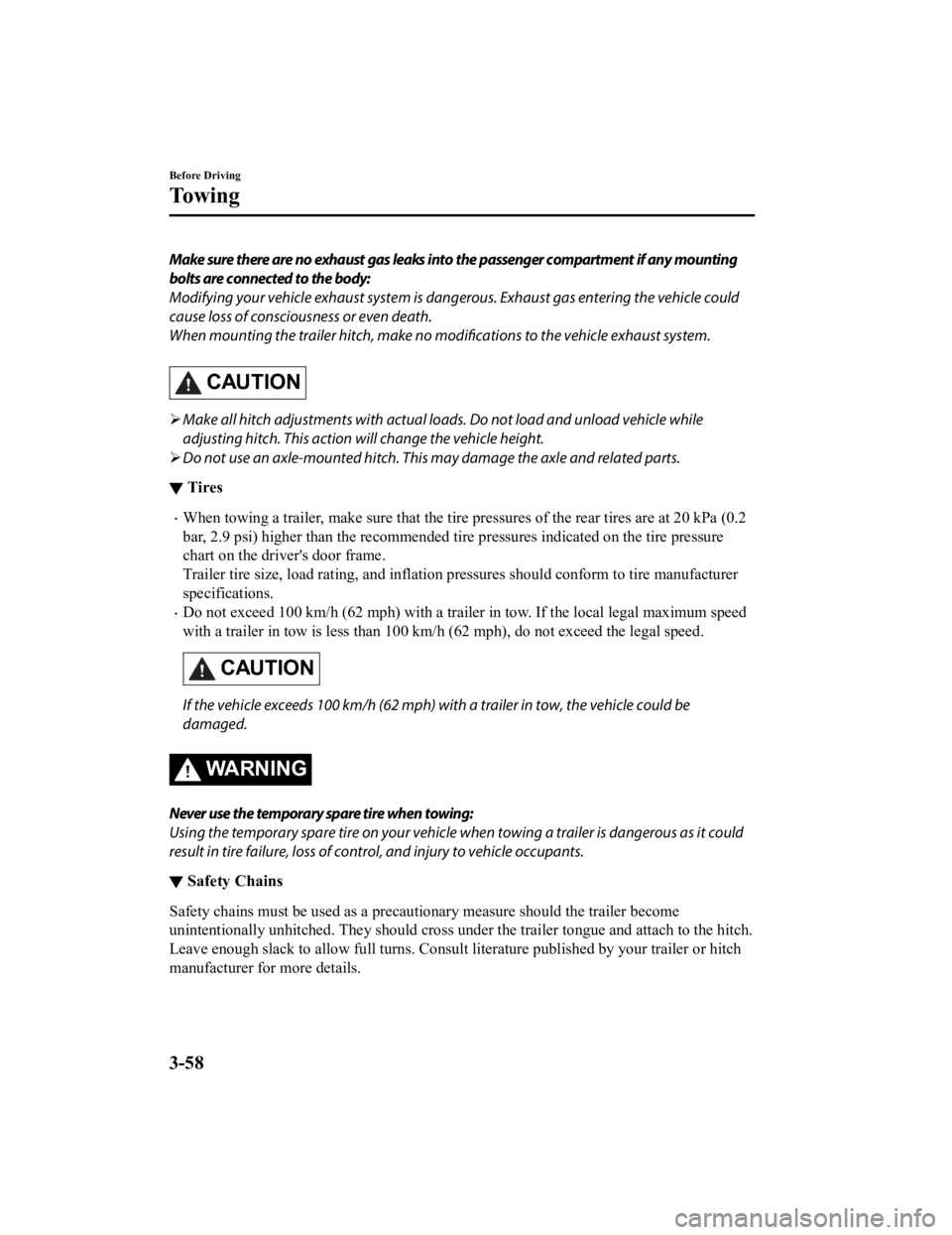
Make sure there are no exhaust gas leaks into the passenger compartment if any mounting
bolts are connected to the body:
Modifying your vehicle exhaust system is dangerous. Exhaust gas entering the vehicle could
cause loss of consciousness or even death.
When mounting the trailer hitch, make no modifications to the vehicle exhaust system.
CAUTION
Make all hitch adjustments with actual loads. Do not load and unload vehicle while
adjusting hitch. This action wi ll change the vehicle height.
Do not use an axle-mounted hitch. This may damage the axle and related parts.
▼ Tires
When towing a trailer, make sure
that the tire pressures of the rear tires are at 20 kPa (0.2
bar, 2.9 psi) higher than the recommended tire pressures indica ted on the tire pressure
chart on the driver's door frame.
Trailer tire size, load rating, and inflation pressures should conform to tire manufacturer
specifications.
Do not exceed 100 km/h (62 mph) w ith a trailer in tow. If the local legal maximum speed
with a trailer in tow is less than 100 km/h (62 mph), do not ex ceed the legal speed.
CAUTION
If the vehicle exceeds 100 km/h (62 mph) with a trailer in tow, the vehicle could be
damaged.
WA R N I N G
Never use the temporary spare tire when towing:
Using the temporary spare tire on your vehicle wh en towing a trailer is dangerous as it could
result in tire failure, loss of control, and injury to vehicle occupants.
▼ Safety Chains
Safety chains must be used as a precautionary measure should th
e trailer become
unintentionally unhitched. They should cross under the trailer tongue and attach to the hitch.
Leave enough slack to allow full turns. Consult literature publ ished by your trailer or hitch
manufacturer for more details.
Before Driving
To w i n g
3-58
CX-9_8LJ2-EA-22H_Edition1_old 2022-6-9 13:33:08
Page 160 of 739
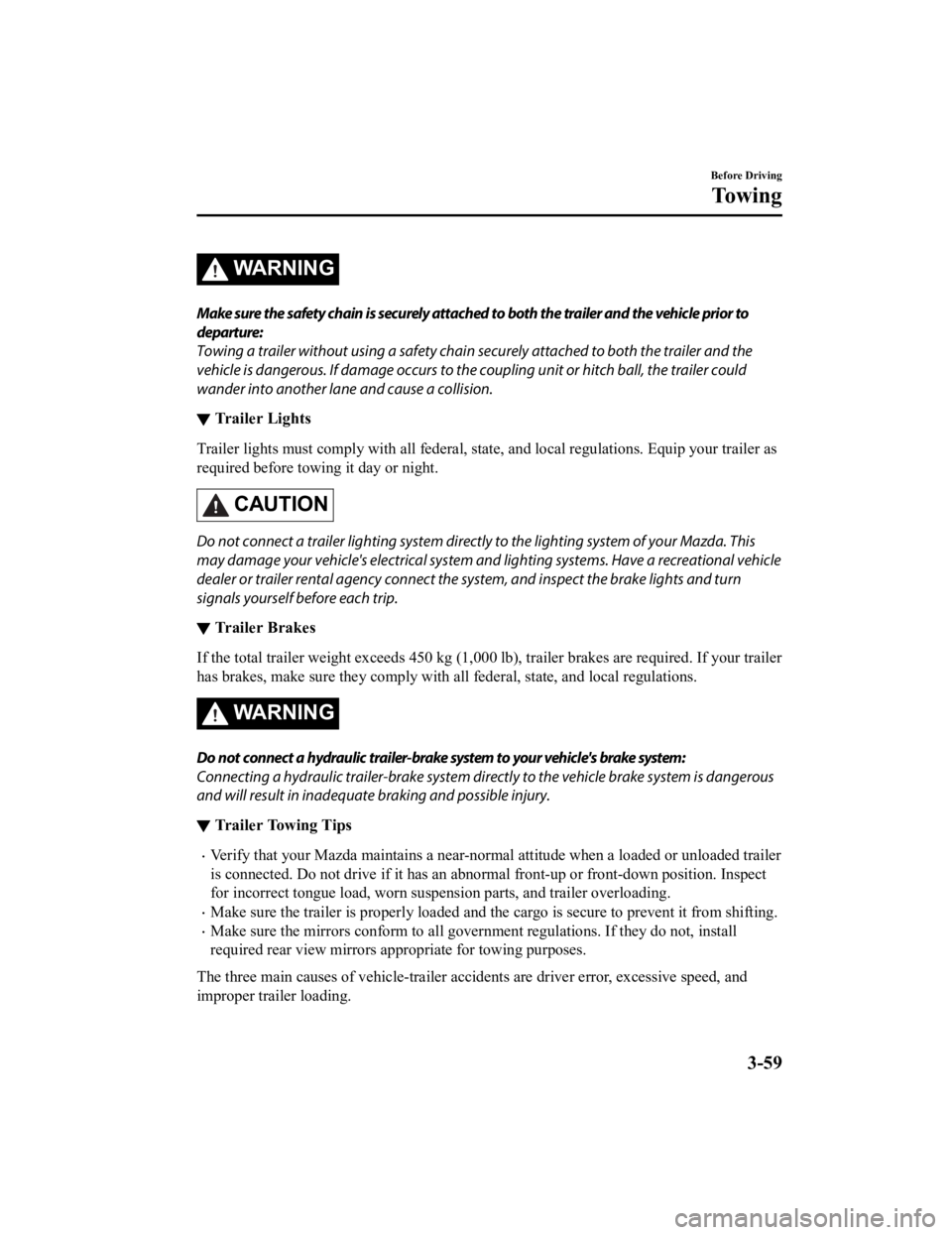
WA R N I N G
Make sure the safety chain is securely attached to both the trailer and the vehicle prior to
departure:
Towing a trailer without using a safety chain securely attached to both the trailer and the
vehicle is dangerous. If damage occurs to the coupling unit or hitch ball, the trailer could
wander into another lane and cause a collision.
▼ Trailer Lights
Trailer lights must comply with a
ll federal, state, and local regulations. Equip your trailer as
required before towing it day or night.
CAUTION
Do not connect a trailer lighting system directly to the lighting system of your Mazda. This
may damage your vehicle's electrical system an d lighting systems. Have a recreational vehicle
dealer or trailer rental agency connect the system, and inspect the brake lights and turn
signals yourself before each trip.
▼ Trailer Brakes
If the total trailer weight exc
eeds 450 kg (1,000 lb), trailer brakes are required. If your trailer
has brakes, make sure they compl y with all federal, state, and local regulations.
WA R N I N G
Do not connect a hydraulic trailer-brake system to your vehicle's brake system:
Connecting a hydraulic trailer-brake system direc tly to the vehicle brake system is dangerous
and will result in inadequate braking and possible injury.
▼ Trailer Towing Tips
Verify that your Mazda
maintains a near-normal attitude when a loaded or unloaded trailer
is connected. Do not d rive if it has an abnormal front-up or fr ont-down position. Inspect
for incorrect tongue load, worn suspension parts, and trailer o verloading.
Make sure the trailer is properly loaded and the cargo is secur e to prevent it from shifting.
Make sure the mirrors conform to all government regulations. If they do not, install
required rear view mirrors appr opriate for towing purposes.
The three main causes of vehicle-trailer accidents are driver e rror, excessive speed, and
improper trailer loading.
Before Driving
To w i n g
3-59
CX-9_8LJ2-EA-22H_Edition1_old 2022-6-9 13:33:08